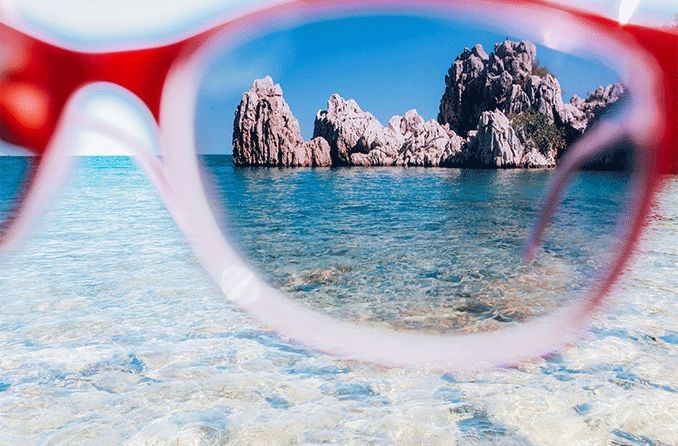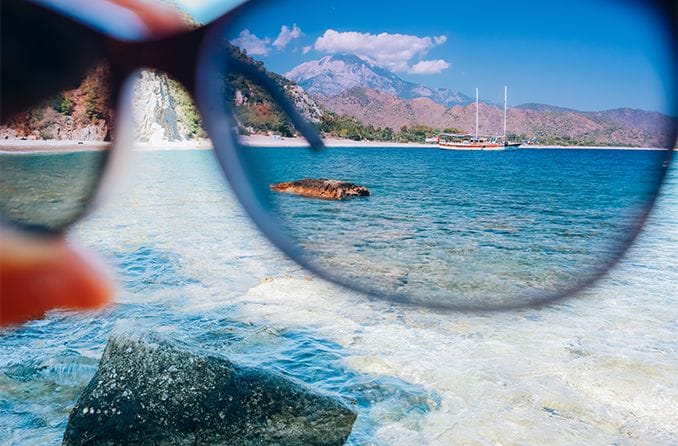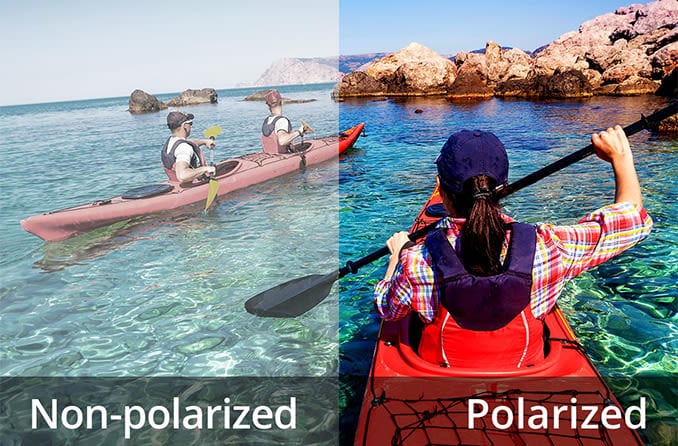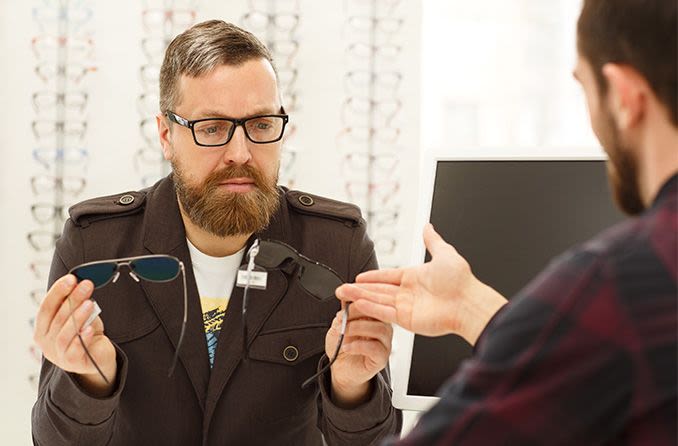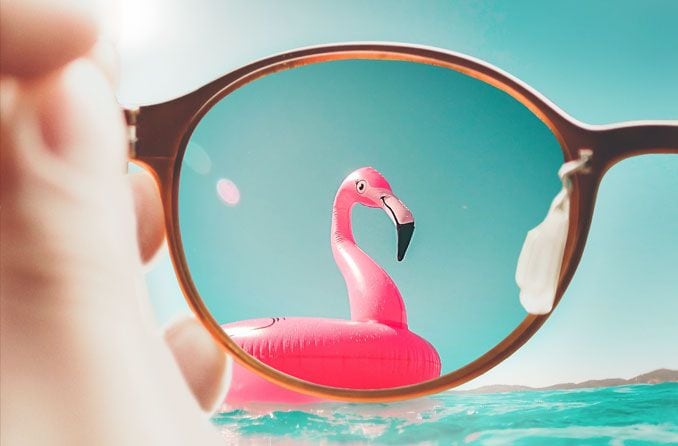Polarized sunglasses are anti-reflective, meaning they help block some of the brightness and glare that can make driving and certain outdoor activities uncomfortable. Polarized lenses can also enhance your vision by boosting colors so that they appear more vibrant.
According to the American Academy of Ophthalmology, polarized lenses work to reduce glare from light bouncing off surfaces such as water or metal, leading to improved visual clarity and comfort in bright or sunny situations.
Whether you need eye protection for driving, boating, playing outdoor sports or another activity, polarized shades can help you see clearly — though you’ll find there are some situations where you shouldn’t use them. Selecting the right sunglasses type for your needs can be a breeze, if you know what to look for.
SEE RELATED: What are the advantages of polarized sunglasses?
What are polarized sunglasses?
Polarized lenses are a type of sunglasses lens that reduces light glare. Like all sunglasses lenses, they allow you to see more comfortably in bright or sunny situations. Unlike regular sunglasses, however, polarized sunglasses allow you to see despite the glare caused by light bouncing off of other surfaces, like the hood of your car.
What do polarized sunglasses do?
In most situations, polarized sunglasses increase visual comfort by filtering both ambient and reflected light. Viewing a bright scene through polarized lenses can also help you see colors more vibrantly and details more clearly than you would without polarization.
It’s important to note that, while polarized lenses can reduce or eliminate the blinding glare of upwardly reflected light, they don’t necessarily provide protection from harmful UV rays. When selecting any sunglasses, including polarized sunglasses, be sure they’re labeled with 100% UVA and UVB protection.
How do polarized sunglasses work?
Lenses become polarized with the application of a special chemical that blocks some — but not all — light from entering your eyes.
This anti-reflective coating only allows light rays to enter vertically, meaning you’re able to see whatever you’re looking directly at. However, they block light from entering at any other angle, such as from the glare of the sun bouncing off snow, a car or a body of water.
This means you’re often able to more clearly see what you’re looking at. It also counters the blinding effect that can be caused by bright light bouncing off surfaces, as these light waves tend to be horizontal rather than vertical.
Another effect of polarization is increased contrast, which contributes to visual clarity as well as enhances colors. So even if you’re looking at a bright, sunny scene, polarized shades can allow you to see vibrant colors rather than just the brightness of reflected light.
Polarized vs. non-polarized sunglasses
Why polarized sunglasses? For certain activities, including daytime driving, water sports and winter sports, you may benefit from wearing polarized sunglasses — especially if light is bouncing off surfaces and into your eyes. Both polarized or non-polarized lens types can help you see more comfortably in bright light, but you’ll want to consider polarized lenses for activities and situations that require a reduction in glare.
Daytime driving
Polarized sunglasses can really come in handy when you’re driving on sunny days. Their anti-reflective coating helps mitigate light bouncing off reflective surfaces in your field of vision — these surfaces include windshields, roads, snow and even the hood of your own car. This makes for a safer driving experience free from distractions or even the temporary blindness that can be caused by particularly intense glare.
However, if you find yourself more frequently driving in overcast conditions, non-polarized sunglasses might be for you. They tend to allow for better vision in low-contrast conditions. Just as you should wear sunscreen to protect your skin from harmful UV rays even on cloudy days, you should also wear UV-protection sunglasses when it’s cloudy as long as you can safely see.
For driving on snowy or icy days, it can actually be safer to wear non-polarized sunglasses. In these cases, you want to be able to see the reflected light that alerts you to ice on the road.
Nighttime driving
If you have trouble seeing the road due to the glare of street lights and headlights, you may be wondering if polarized glasses can help you with nighttime driving. The answer is no: You should never wear sunglasses in low-light or dark conditions. While they might be able to address the issue of reflection from headlights and street lights, they’ll ultimately cause more issues by making it too dark to see anything else.
There are anti-reflective night driving glasses made specifically for seeing better in low-light conditions. However, like polarized sunglasses, these can actually inhibit your vision rather than providing more clarity as intended. If you wear prescription glasses, opt for clear lenses with an anti-reflective coating to make sure the glasses themselves aren’t causing glare issues from headlights and streetlights.
Outdoor activities
Polarized lenses can be useful for outdoor activities, particularly when outside light is intensified by glare — when you’re on the road, for instance, or on a body of water. However, there are also outdoor activities for which polarized glasses are not recommended.
Instances where polarized sunglasses can be helpful include:
- Fishing: When you’re on or near a body of water, polarized lenses can help you see more clearly by cutting down on the glare from the water’s reflection. This also means you’re better able to see past the surface of the water, which provides a huge advantage for fishers.
- Water sports: If you’re sailing, kayaking or canoeing — or doing any number of other water sports — polarized lenses can ease the strain on your eyes from the water’s glare. Plus, they’ll help you see more underwater wildlife.
- Hiking: Polarized lenses are ideal for scenic views, as they help enhance colors so you can see vibrant landscapes more clearly.
Polarized sunglasses may not be the best choice for other outdoor activities, such as:
- Winter sports: While you may think polarized goggles or glasses would be helpful while skiing or snowboarding, not being able to see the glare from snow and ice during these activities can actually be detrimental. That’s because this reflection alerts you to dangerous icy patches, which allows you to avoid them.
- Bicycling and running: Using polarized sunglasses comes down to personal preference. Some cyclists and runners wear polarized shades to filter both ambient and reflected light, while others feel safer maintaining the ability to see reflected light.
Looking at screens
When it comes to looking at screens — like your smartphone, laptop or an ATM — polarized sunglasses aren’t going to do you any favors.
That’s because the anti-reflective coating on polarized lenses distorts digital screens, making them appear faded or completely dark depending on the angle from which you’re viewing the screen. This can be annoying because you’ll have to remove your sunglasses any time you want to check your phone to see the time or read a text message. It can also be frustrating for anyone who uses a car dashboard mount in order to see digital maps while driving. Non-polarized sunglasses won’t cause this type of visual distortion.
If you find yourself experiencing glare when looking at screens, you might benefit from blue light glasses. These are made specifically for indoor use, for those who spend a lot of time looking at screens, either for work or leisure. Like polarized lenses, blue light lenses are covered with a special coating — but this one specifically filters blue light.
Are polarized sunglasses better?
Your choice of polarized or non-polarized lenses depends on your personal needs and how you plan to use them. For many people, having a pair of each type of sunglasses can be beneficial for use in different situations.
If you’re trying to determine whether polarized sunglasses are right for you, here are the benefits and disadvantages.
Benefits of polarized sunglasses
Polarized lenses filter both ambient and reflected light, so they can really ease the eye strain that comes from being in a bright environment. This not only improves your eye health and helps you avoid distractions and temporary blindness caused by glare, but it also helps you see bright scenes more clearly and colors more vibrantly.
If your eyes are exposed to too much light, it can make it difficult or impossible to see. That’s why polarized sunglasses provide a huge benefit for daytime driving, boating and fishing — they help you see despite overhead light from the sun as well as reflected light from cars or water.
Polarized lenses can also enhance your vision for outdoor activities like birdwatching, hiking and scenic walks, where being able to see clearly is a priority. They increase comfort and visual clarity while also making images appear sharper. Often, tinted sunglasses can distort color, but polarized sunglasses can actually counteract that distortion.
Disadvantages of polarized sunglasses
Polarized sunglasses can make it difficult to see LCD screens like phones and laptops. This can be especially problematic if you rely on a digital dashboard display or cell phone when routing in your car. If this is the case, you may want to opt for non-polarized lenses when you need to see a map while driving.
In low-light situations, polarized lenses may actually block too much light. They’re best in bright contexts. When there’s too much cloud cover or the sun is setting, it’s still good to wear sunglasses with UV protection for your health, but you may not need polarization. They’re also not suitable for nighttime driving, as they’ll darken the overall scene too much.
Finally, they’re usually more expensive than standard tinted lenses. However, for many users — including those who drive, hike or boat — they’re worth it.
Prescription polarized sunglasses
Prescription sunglasses are available with or without an anti-reflective coating. Choosing polarized lenses can be worth it if you’ll wear your sunglasses for daytime driving or boating activities, but you may want to opt for non-polarized sunglasses if you’ll use them for sports — especially if these will be your only pair of shades. You can get prescription polarized sunglasses in a variety of stylish frames.
Are polarized sunglasses worth it?
Paying slightly more for polarized sunglasses is worth it for many people, though they aren’t right for everyone. It’s important to consider how you plan to use your sunglasses, and in which situations you plan to wear them.
Polarized sunglasses are usually worth it for anyone who will be using sunglasses while fishing, boating or daytime driving. They can also help enhance color and clarity when viewing outdoor scenery.
In general, everyone needs UV protection for their eyes, so the most important consideration when buying sunglasses is to make sure they offer 100% UVA and UVB protection. And while an anti-reflective coating can also help keep you safe in the sun by reducing harsh glare, you should talk to an eye doctor about whether polarized lenses are best for you if you aren’t sure what you need.
LOOKING FOR SUNGLASSES? Find a nearby optical store and get the perfect pair of shades.
SEE RELATED: National Sunglasses Day
